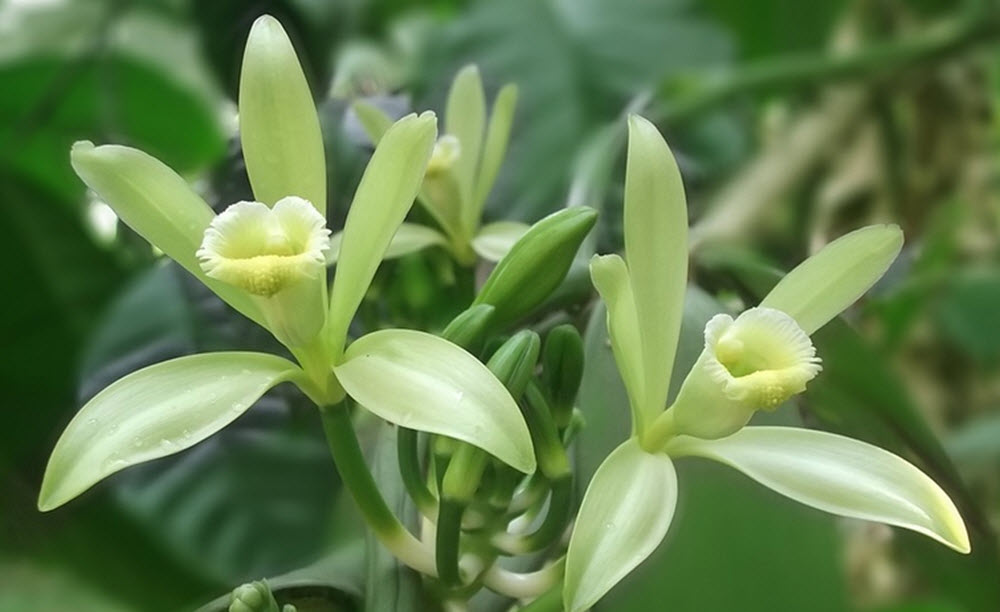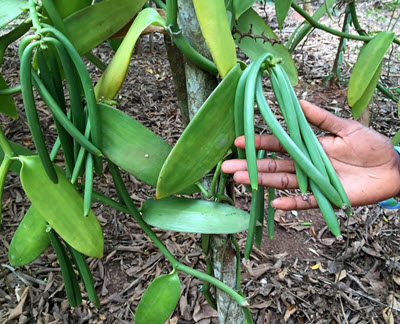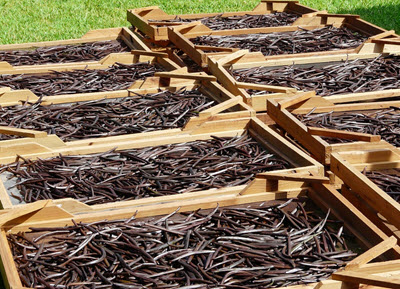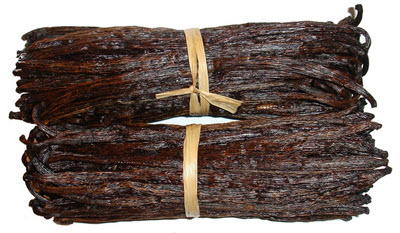Vanilla orchid
Contents
Vanilla plant or vanilla orchid refers to any of the 110 species in the genus vanilla. The most common species is Vanilla planifolia, the vanilla orchid used to make commercial vanilla flavouring. The name vanilla comes from the Spanish word vainilla, a diminutive form of the word vaina which means sheath. The word vaina is in turn derived from the Latin word vagina, which means “sheath” or “scabbard”.

Vanilla is appreciated for its aroma and taste and is used in food as well as in perfumes. The flavor components in vanilla are bound as glycosides and must be freed by an enzymatic reaction. This is why it is necessary to cure vanilla before it can be used in food or perfumes.
In commercial vanilla plantations, the by far most commonly grown species of vanilla is Vanilla planifolia, but some growers also cultivate Vanilla pompona and Vanilla tahitensis. Today, scientists specializing in biotechnology are working to improve and optimize the naturally occurring vanilla flavor and it is for instance common to set up tissue cultures where orchid plant cells with desirable characteristics can be propagated in large numbers.
The members of the genus Vanilla are all vines and need a structure to cling on, such as a tree in the forest. The vine can be over 35 meters long, provided that it has a suitable structure to cling on. Succulent oblong shaped leaves that can reach a size of 12 cm (3.75 inches) are formed singularly and alternately along the length of the plant. In some species, the leaves have developed into scales or almost vanished altogether. In species with very small leaves, the necessary photosynthesis is believed to be carried out in the green stem instead. From the nodes opposite the leaves, aerial roots will develop, just as in many other orchids.
Vanilla flowers grow in clusters that normally comprise 12-20 flowers but can contain up to 100. A cluster can be over 15 cm (6 inches) long with white, cream colored, green or greenish yellow flowers. Most species of vanilla exude a sweet scent from their flowers. The fruit of the vanilla orchid is commonly referred to as the “vanilla bean”. The seeds are protected inside an elongated fleshy pod that can be up to 24 cm (10 inches) long.
Growing vanilla orchid
This growing guide is for Vanilla planifolia, but it can work for many other orchids in the vanilla genus as well. It is however always best to obtain instructions regarding the specific vanilla species you wish to keep since their preferences do vary somewhat.
Watering Vanilla plants
 The initial media is only for support until vine gets established and attention should, therefore, be focused chiefly on aerial roots when it comes to feeding and watering. Water your vanilla orchid frequently and try to resemble the natural environment in tropical Mexico.
The initial media is only for support until vine gets established and attention should, therefore, be focused chiefly on aerial roots when it comes to feeding and watering. Water your vanilla orchid frequently and try to resemble the natural environment in tropical Mexico.
Nutrients for Vanilla orchids
Feed your vanilla orchids ½ teaspoon of fertilizer every two weeks, preferably of the urea-free 20-10-20 variety. It is safer to dilute the fertilizer and serve over the course of several days instead of giving your orchid one large feeding every second week.
Vanilla orchid temperature
The vanilla orchid appreciates a change between day and night temperatures. 27-32º C (80-90º F) is ideal during the day, while the preferred night temperature is 15.5-21º C (60-70º F).
Vanilla orchid light
Place your vanilla plant in a spot where it will receive direct sun from morning to noon and bright shade from noon to evening. In the wild, the vanilla orchids are normally exposed to light that is filtered down through the forest canopy. This type of partial shade will shelter the orchids from direct afternoon sun.
Potting medium for a Vanilla orchid
The medium is only used for support until the vanilla orchid, which is a vine, gets established on its support. The vanilla orchid will produce aerial roots and absorbed water and nutrient through them. Many different types of potting media can be used, from bark or moss to pebbles or tire treads.
Repotting a Vanilla plant
As mentioned above, the potting medium will only be used for support until the vanilla orchid gets established.
Pruning of Vanilla plants
Flowering and pollination
The buds on a vanilla orchid will develop into lateral branches and the flowers bloom on these branches. Each branch can have up to 20 buds opening over a month or so.
The vanilla flower relays on the Melipona bee for pollination so unless you happen to live in a part of Mexico where Melipona bees occur, you will need to hand-pollinate your orchids if you want them to produce fruits. A vanilla flower that is not pollinated will simply wilt and fall off.
Each flower must be pollinated shortly after opening so be prepared to check your orchids frequently for new open flowers. A vanilla flower will open up in the morning and close itself late in the afternoon, never to re-open again.
During hand-pollination, the most common method involves using a small splinter of wood or a grass stem to carefully lift the rostellum (i.e. flap) out of the way and press the overhanging anther against the stigma. This will result in self-pollination and eventually vanilla beans. Commercial growers will normally only pollinate a few flowers on each stem since this leads to beans of a higher quality.
Picking and preparing vanilla beans
 Both the pod and the seeds are used for their taste and aroma. The fleshy pod with the seeds inside will ripen gradually and eventually become dark brown or blackish and start giving off a powerful scent. It can take over 9 months for this to happen. Do not remove the vanilla pods until the beans are firm and fully formed inside the pod. Wait until the bean is has begun to split. The best quality is attained if the pod is picked just as it splits. It is important to remember that each bean will ripen at its own time. If you get impatient and pick the beans too early while they are still too green, the vanilla will be less flavorsome.
Both the pod and the seeds are used for their taste and aroma. The fleshy pod with the seeds inside will ripen gradually and eventually become dark brown or blackish and start giving off a powerful scent. It can take over 9 months for this to happen. Do not remove the vanilla pods until the beans are firm and fully formed inside the pod. Wait until the bean is has begun to split. The best quality is attained if the pod is picked just as it splits. It is important to remember that each bean will ripen at its own time. If you get impatient and pick the beans too early while they are still too green, the vanilla will be less flavorsome.As mentioned earlier, the flavor components in vanilla are bound as glycosides and must be freed through an enzymatic reaction. This is called curing and several methods have been developed. Don’t hesitate to try several methods and combination of methods in order to find out which method you prefer.
Method # 1: sun drying
Spread the beans on trays and place the trays in the sun. Leave the beans to dry in the sun for 2-3 hours. Fold the beans into blankets and leave them to sweat overnight. Continue the process until the beans become deep brown and bendy, i.e. let the beans dry in the sun each day and leave them to sweat each night. This can take up to three weeks. Place the deep brown beans in the shade on a well-ventilated spot and let them dry for 2-4 weeks.
Method # 2: hot bath
Heat up water to a temperature of 57-88 degrees C (89-120 degrees F). Bathe the beans in the hot water for 2-3 minutes. Sweat the beans in blankets overnight and leave them to dry in a well-ventilated spot afterward.
Vanilla history
As far as we know, the Totonaco people of the Vera Cruz region in Mexico were the first ones to cultivate vanilla orchids. Unlike many fruits and berries, the vanilla bean seems completely inedible when you first come across it since it needs to be cured in order to divulge its unique aroma. The Totonacos probably found vanilla beans that had been cured by months of heat and humidity in the tropical forest and realized the secret. According to Totonaco myths, the blood of two lovers had fallen onto the forest floor, causing a vigorous vine with a beautiful flower to spring up. The vanilla was a gift from the gods and its purpose was to fill the air with the scent of true love and beauty.
In 1427, the Aztec ruler Itzcoatl conquered the Totonaco people and learned about the mysterious vanilla. He immediately grew fond of the taste and aroma and the Aztecs began using vanilla to flavor their cacahuatl, a drink made from water, honey, ground corn and cocoa beans. The Aztec name for the vanilla bean is tlilxochitl (pronounced tea-so-shill), which literary means “Black Flower”.
 The Aztecs didn’t produce any vanilla on their own; they forced the Totonacos to pay their taxes to the Aztec ruler in the form of high-quality vanilla beans. Vanilla was believed to have medical properties and was used to treat a wide range of problems, from indigestion and headaches to animal bites and poisonings. In addition to this, vanilla was considered an aphrodisiac by the Aztecs as well as the Europeans and many people still find the taste and smell of vanilla erotic and invigorating.
The Aztecs didn’t produce any vanilla on their own; they forced the Totonacos to pay their taxes to the Aztec ruler in the form of high-quality vanilla beans. Vanilla was believed to have medical properties and was used to treat a wide range of problems, from indigestion and headaches to animal bites and poisonings. In addition to this, vanilla was considered an aphrodisiac by the Aztecs as well as the Europeans and many people still find the taste and smell of vanilla erotic and invigorating.
In 1519, Spanish Conquistador Cortez came in contact with cacahuatl in Tenochtitlan, the capital of the Aztec Empire, and this resulted in him sending cocoa beans as well as vanilla beans back to Europe. For quite a long time, vanilla was only used to flavor chocolate in Europe, but eventually, the Europeans began experimenting with the beans and use them for more and more culinary adventures. As mentioned above, vanilla was also regarded as having medical and aphrodisiacal properties. One important name in the history of vanilla is Hugh Morgan, Queen Elizabeth’s apothecary, who in 1602 suggested that vanilla should be tried as a flavoring of its own in the United Kingdom instead of being used in conjunction with cocoa only.
Well into the 17th century, no one knew how to cultivate vanilla orchids outside its native range and all vanilla beans had to be imported from Mexico. Plantations were started in many countries with a suitable climate, but the orchids never bore fruit. According to some sources, this was referred to as “the course of Moctezuma”. In 1836, Charles Morren – Belgian botanist, horticulturist and Professor at the University of Liège – realized that the vanilla flower cannot be pollinated by any other insect than the tiny Melipone bee. This small be is native to Mexico and this is why all the attempts to cultivate vanilla orchids outside its native range had failed.
Charles Morren developed a method that made it possible for vanilla plant growers to hand-pollinate the flowers and within soon, vanilla orchids were grown on a significant scale on several tropical islands colonized by the French in the East and West Indies, the Indian Ocean, and French Oceania. The British brought the orchids to Southern India, while the Dutch set up plantations in Indonesia.
The next important step in the history of vanilla was taken by a former slave named Edmond Albius. Edmond Albius lived on Reunion, an island off Madagascar’s coast where vanilla orchids had been planted by the French. Albius developed and perfected a method of hand-pollination that was superior to all the older ones and this method is still in use today, in the 21st century.
Today, roughly 75 percent of all vanilla is grown on Madagascar, Comoros, and Réunion.
Madagascar is an island nation in the Indian Ocean off the south-eastern coast of Africa. Comoros is a smaller island nation located between northern Madagascar and northeastern Mozambique. The island Réunion is a French overseas département situated east of Madagascar, roughly 200 km (130 miles) southwest of Mauritius. Other major producers are found in Indonesia, Tonga, Tahiti, and Mexico.
Economic importance of the vanilla plant
The vanilla plant is an economically important species. The global production exceeds 8000 tons. Most vanilla is grown in Madagascar, Comoros, and Réunion but India and a number of other countries are producing more and more vanilla. The vanilla is used for flavoring a very large selection of different products and many companies are depending on the availability of vanilla for their production. An increased price of vanilla can have a large effect on the profitability of many companies unless they chose to send the increased cost on to the customer. A lot of companies buy futures to hedge themselves against future price increases. This allows them to better predict their future results. Retail investors can also invest in these futures by buying them on the futures market or by buying binary options based on the commodity.
Tips!
Make your own vanilla extract at home. There is a wide range of different recipes for vanilla extract, but they all include vanilla beans and some type of alcohol, e.g. vodka, rum or tequila. If you want a really strong extract, use high proof alcohol. If you want a weaker extract, go for lesser proof alcohol.
Method # 1: Pour a pint of alcohol, e.g. vodka, into a glass bottle with an airtight lid. Add one vanilla bean. Make sure that the lid is well fastened. Shake once a day for 2-3 weeks.
Method # 2: Place two vanilla beans in a glass bottle with an airtight lid. Pour ½ cup of alcohol into a small saucepan and heat up until it starts to smoke. Do not let the alcohol boil! Pour the warm alcohol into the glass bottle. Make sure that the lid is well fastened. Shake once a day for 1-2 weeks.
- If you want a stronger extract, scrape the seeds from the bean instead of using intact beans. After scraping the seeds from the bean, you can add the pods to the alcohol as well.
- You can strain the extract after two weeks using a coffee filter or a very fine strainer, but this is not mandatory.
In Other Languages: Vanilj orkide på Svenska